
We send best wishes to IM Christopher R Beaumont on his birthday, 28th October 1952.

We offer best wishes to IM Simon John Bradley Knott on his birthday
Simon was born on Sunday, October 19th 1958 in Lambeth, London to Simon Harold John Arthur Knott and Josephine Whowell.
Simon attended Trinity College, Cambridge.
He became a FIDE Master in 1990 and an International Master in 2001. According to Felice and Megabase 2020 his peak FIDE rating was 2401 in October 2002 at the age of 43.
Simon was Southern Counties (SCCU) champion in the 1995-96 and 2001-02 seasons.
Simon plays for Hertford and Barbican in the Four Nations Chess League.
As white Simon plays the Queen’s Gambit via a 1.Nf3 or 1.c4 move order. There are zero 1.e4 games!
As the second player he plays the French Winawer and the Grünfeld Defence.



Luke McShane has made a welcome return to chess journalism as the columnist for The Spectator. At fifteen Luke provided a regular column for The Express on Sunday and, until recently, was a busy full-time trader at Goldman Sachs.

The first chess columnist for The Spectator was Conel Hugh O’Donnell Alexander who was followed by Raymond Keene who “retired” in 2019.
Luke’s most recent article may be found here.

We look forward to original and interesting articles from Luke !
BCN remembers Charles Fox (09-xi-1866 11-x-1935)
Charles Masson Fox was born on Friday, November 9th 1866 in Falmouth, Cornwall. his father, Howard, was 29 and his mother, Olivia Blanche Orme, was 22. He had one brother and two sisters.
His sister Olivia Lloyd was born on 5 February 1868 in Falmouth, Cornwall, when Charles Masson was 1 year old. His sister Stella was born on 11 December 1876 in Falmouth, Cornwall, when Charles Masson was 10 years old. In 1881 he was living in Sherborne, Dorset. In 1901 he was once more living in Falmouth and his profession was that of a timber merchant. His brother Howard Orme died on 7 June 1921 in Falmouth, Cornwall. His father Howard passed away on 15 November 1922 in Cornwall. His mother Olivia Blanche passed away on 12 March 1930 in Falmouth, Cornwall, at the age of 85.
Sadly, neither Hooper & Whyld, Sunnucks or Golombek mention Fox in their works.
Here is an extensive article from the British Chess Problem Society (BCPS) written by CJ Feather
From Wikipedia :
“Charles Masson Fox (9 November 1866 – 11 October 1935) was a Cornish businessman who achieved international prominence in the world of chess problems and a place in the gay history of Edwardian England.
Masson Fox was born into a Quaker family (although he was not related to the Quakers’ founder George Fox) and was a cousin of the fraudulent sinologist Sir Edmund Backhouse, 2nd Baronet. Living throughout his life in the Cornish seaside town of Falmouth, Fox in the early decades of his life was a senior partner of his family’s timber firm, Fox Stanton & Company, and was also on the Board of Messrs G C Fox & Company, a long-established firm of shipping agents.
C.M.Fox’s gravestone at Budock Quaker Burial Ground
Fox is described by chess historian Thomas Rayner Dawson (1889–1951) as “a friendly man, kind, mellow, lovable, bringing peace and comfort and serene joy with him”. He was also a discreet but active homosexual. In 1909 he visited Venice with his friend James Cockerton, meeting the writer Frederick Rolfe and becoming the reluctant recipient of Rolfe’s famous Venice Letters, in which the gay subculture of Venice is vividly described.
In 1912–13 Fox was blackmailed by a woman who accused him of seducing her 16-year-old son. Eventually Fox reported the matter to the police and the woman was sent to prison for five years and her son for one year, with hard labour.[1] However, Fox was profoundly affected by the publicity surrounding the case, which was reported in detail in the local press. The predictable result of his courageous action was the destruction of his reputation, and the compromise of his business and social life in Falmouth.
Although he continued to live in Cornwall, the focus of his social life shifted to London, and in the last two decades of his life, Fox became prominent in the world of chess. He was elected President of the Cornwall Chess Association, played a prominent part in the development of the British Chess Problem Society, and is still renowned as one of the greatest ever exponents of fairy chess (chess problems with variations in the rules).”
From The Problemist Fairy Chess Supplement, 1933 :
What is the shortest game
ending in this position?

We send best wishes to WFM Sarah Natasha Longson (née Hegarty) on her birthday this day, (October 2nd) in 1988.

From Sarah’s web site :
“I have played competitive chess since the age of 7 when I became UK U7 Girls Chess Champion and appeared on Blue Peter where I met the then world champion Garry Kasparov. Since then I have represented England in many international competitions and in 2013 won the British Ladies Championship.”
In 2016 Sarah and partner FM Alex Longson made a successful bid for ownership of the UK Chess Challenge which was auctioned by the bankruptcy receiver of IM Mike Basman, the previous owner.
Sarah and Alex have modernised the UKCC considerably especially in the areas of communications and usage of IT.

According to the ECF Sarah’s nominal club is Marple but she also plays for Stockport and 4NCL 3Cs.
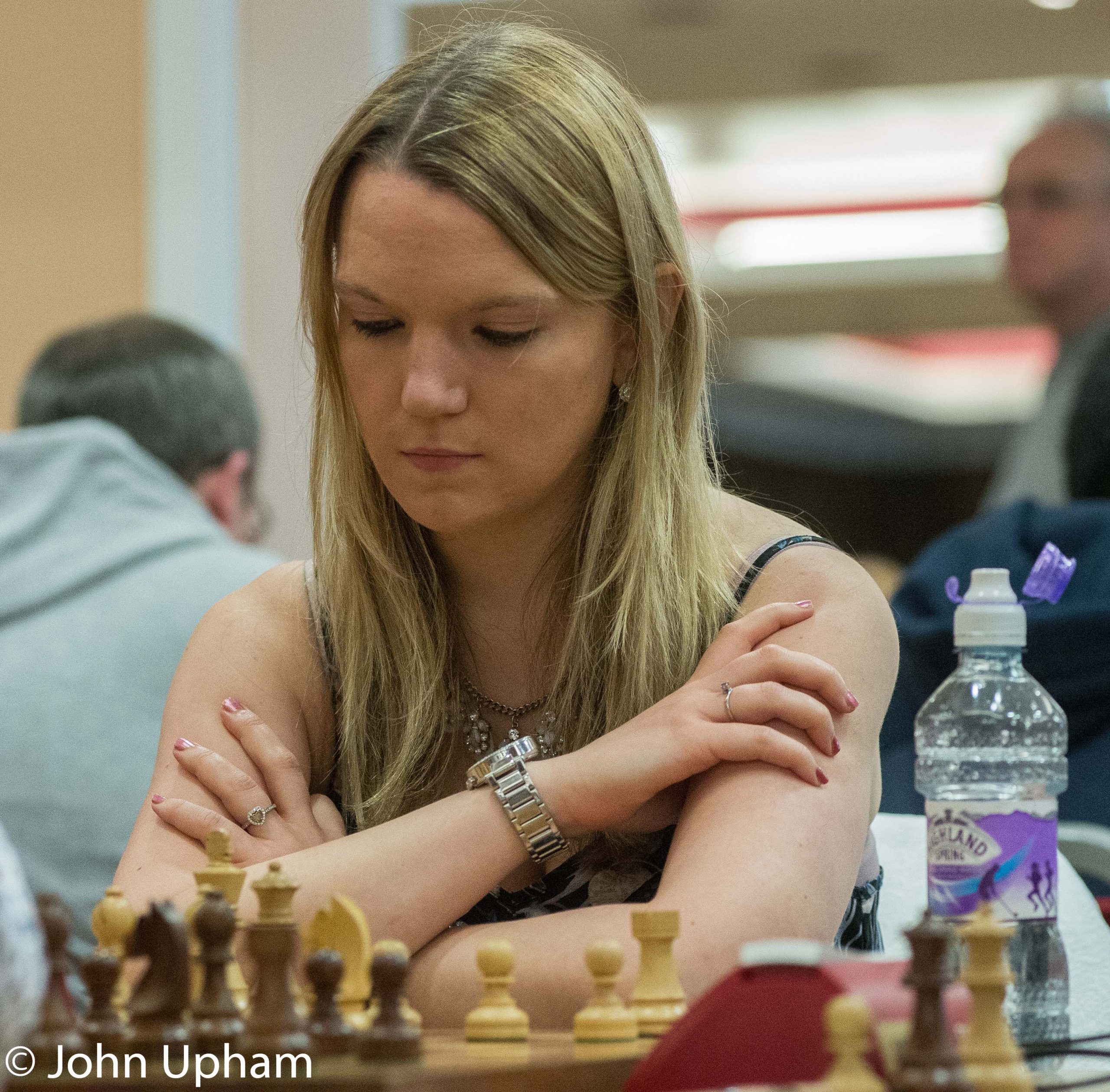

We send best wishes to Richard Kenneth Guy on his 102nd birthday, this day (September 30th) in 1916
From Wikipedia :
Richard Kenneth Guy (born 30 September 1916) is a British mathematician and professor emeritus in the Department of Mathematics at the University of Calgary.[1] He is known for his work in number theory, geometry, recreational mathematics, combinatorics, and graph theory.[2][3] He is best known for co-authorship (with John Conway and Elwyn Berlekamp) of Winning Ways for your Mathematical Plays and authorship of Unsolved Problems in Number Theory.[4] He has also published over 300 papers.[5] Guy proposed the partially tongue-in-cheek “Strong Law of Small Numbers,” which says there are not enough small integers available for the many tasks assigned to them – thus explaining many coincidences and patterns found among numerous cultures.[6] For this paper he received the MAA Lester R. Ford Award.[7]
From 1947 to 1951 Guy was the endings editor for the British Chess Magazine.[40] He is known for almost 200 endgame studies. Along with Hugh Blandford and John Roycroft, he is one of the inventors of the GBR code (Guy–Blandford–Roycroft code), a system of representing the position of chess pieces on a chessboard. Publications such as EG magazine use it to classify endgame types and to index endgame studies.[41]


A glorious Saturday (the 14th) in September was the date and Camberley Baptist Church was the location of the third tournament in memory of correspondence Grandmaster Keith Bevan Richardson.

A field of thirty-two gathered at the home (since 1982) of Camberley Chess Club for a six round rapid-play event (R20′ + 10″) that was free to enter raising money by donations to The Cure Parkinson’s Trust. Players were invited to choose books from Keith’s library

and donate to charity in return.

Top seed was recently qualified IM Adam C Taylor (ECF230)
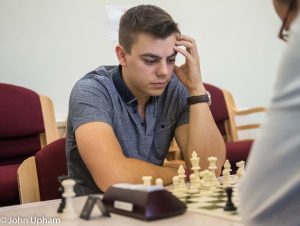
whose chances were dented by losing in round 4 to Clive Frostick (Farnham) who, like Keith, was a highly successful correspondence player (a SIM : Senior International Master)

Other pre-tournament favourites were FM Andrew P Smith (IRE and Bourne End)
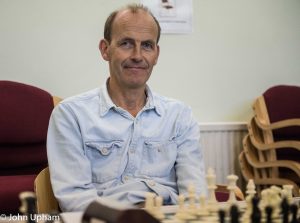
and FM Richard M Webb (Crowthorne)

along with WFM Louise Head (Crowthorne)

Following three rounds we stopped for lunch (in some cases liquid only) and on 100% were Adam, Clive and Andrew so round four could well be a key decider. Clive beat Adam with the white pieces whereas Andrew and Richard drew a hard fought Sicilian Dragon. In round five Clive breathed a sigh of relief to survive a “dodgy” position against Colin Purdon in one of the candidate games for the “Best Swindle” Prize.
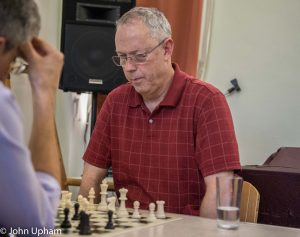
The drama continued into the final round as Adam beat strong junior Ranesh Ratnesan
and everything hinged on Clive’s game with Richard Webb. After a long and interesting struggle the game was drawn and the tournament was decided.
The award for Best U-150 player went to rapidly improving Jessica Mellor (Guildford)

the award for Best Junior went to Radesh Ratnesan (Surbiton)

and the title of Camberley Chess Club Champion (highest placed local player) went to Colin Purdon

In overall first place with 5.5/6 was Clive Frostick :

The event collected more than £300 for the Cure Parkinson’s Trust and we are sure Keith was looking down from above and was pleased with what he observed.

Past Winners of Keith Richardson Memorial :
2017 : Julien Shepley
2018 : Ken Norman
2019 : Clive Frostick
Full results may be found from UTU Swiss
Camberley Chess Club would like to thank :
Camberley Baptist Church, Berkshire Junior Chess Association, Ken Coates and Christine Coates.
The organiser was John Upham.
He was British Correspondence Champion in 1972 and awarded the IMC title in 1981.
According to Kings Indian I Attacking Systems :
“British Correspondence Champions 1971/72. Placed second in an ICCF master tourney 1973/76. A member of the British team in the 9th Olympiad 1977/80. Gained the IMC title in the European Team Championship 1978/81.”
According to Chessbase Correspondence Database 2020 Frank achieved his highest (ICCF) rating in January 1991 of 2410.

As White Frank would play the Queen’s Gambit via a 1.Nf3 move order. He did not play 1.e4
As the second player he would defend the closed Ruy Lopez and the Nimzo-Indian Defence.


Sixty-four (!) players entered the South-West qualifier for the British Blitz Championship 2019 held at Bristol Grammar School for a fifteen round tournament employing a 3′ + 2″ FIDE approved time control.

The entry was headed by GM Matthew Turner (SCO) scoring 13.5/15 and gaining a mere 8.8 FIDE Blitz rating points drawing quickly with Keith Arkell and losing to FM Lewis Martin (ENG).
Paignton based “local” GM Keith Arkell (ENG) took runner-up spot with 12/15 losing 15 rating points having drawn with Lewis Martin but losing to in-form IM James Cobb (WLS) and IM Malcolm Pein (ENG). Malcolm’s son Jonathan elected to play in the much weaker Belfast qualifier which was probably a good move.
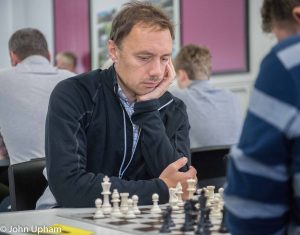
Highest placed lady player (and therefore qualifier) on 8.5/15 was University of Warwick student and reigning English Ladies Champion, WFM Louise Head (ENG) who was supported by her Crowthorne team mates FM Richard Webb, Colin Purdon and Mark Taylor.

Surprise performance (perhaps?) was from FM Lewis Martin (title awarded in 2018) who beat Matthew Turner, Malcolm Pein, Richard Webb and Louise Head of the titled players to earn a 64.8 rating increase.

Full results may be found at Chess Results . com